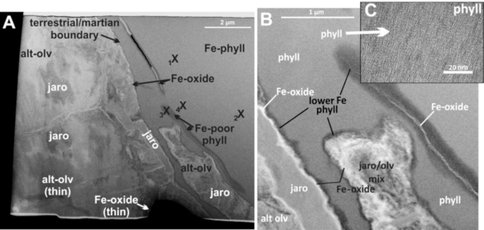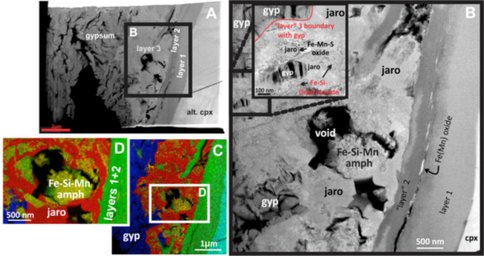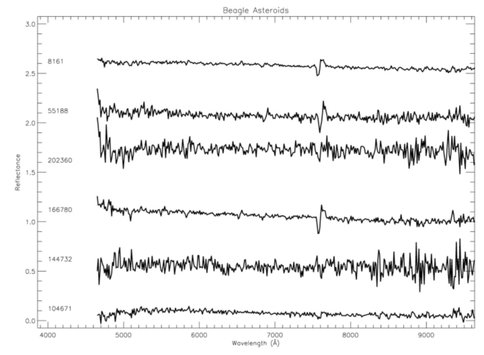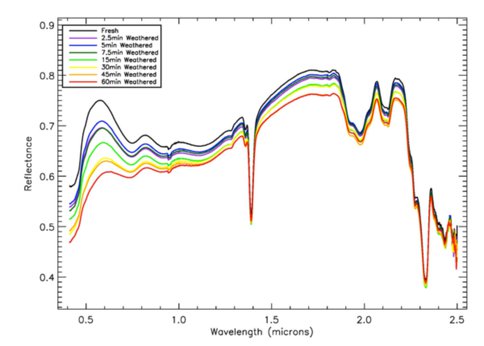2013 Annual Science Report
 University of Hawaii, Manoa
Reporting | SEP 2012 – AUG 2013
University of Hawaii, Manoa
Reporting | SEP 2012 – AUG 2013
Alteration of Asteroid Surfaces, Martian Meteorites and Terrestrial Rocks
Project Summary
The inner solar system is relatively dry, but recent discoveries of water ice on the Moon, the subsurface of Mars, and potentially on a small class of asteroids known as main belt comets (MBCs), has forced us to re-evaluate our understanding of the inner solar system volatile distribution. Understanding the water content in asteroids and its evolution with time will be critical to constrain the origin and evolution of water in the asteroid belt.
Interpreting the early aqueous history of the solar system requires an understanding of the processes that alter the original materials, including secondary alteration of minerals within parent bodies, and processes termed space weathering that influence surface layers. The nakhlite group of Martian meteorites is known to contain secondary alteration minerals that formed on Mars. We studied the fine-scale mineralogy and chemistry of these alteration minerals, and compared them to terrestrial alteration minerals formed in the Antarctic. The aim of these comparisons was to determine whether conditions such as water/rock ratio, pH and temperature were similar during the formation of alteration minerals in both planetary environments. Hence, the suitability of the Antarctic as a martian analogue site was tested.
The distribution of MBCs and asteroids with hydrated minerals provide us with a tool to constrain the position of the snow line within the asteroid belt, which has important implications for the origin and distribution of volatiles for the terrestrial planets. However we need to understand the processes that alter the surface composition to be able to interpret the observations in the context of early solar system volatile distribution. Space weathering has been largely associated with “dry” S-type asteroids and is known to decrease the absorption depths and redden the spectral slopes of their surfaces. Only recently have studies indicated that C-type asteroids experience space weathering as well. Currently there are two contrasting views of how space weathering modifies the surfaces of these asteroids. One study found that the spectral slopes become redder with age, similar to S-type asteroids, but another study found that the spectral slopes become neutral with age. This discrepancy has been attributed to sampling effects and differences in mineralogy among C-type asteroids.
Project Progress
Secondary Aqueous Processes
Both Antarctic terrestrial rocks and the Martian meteorites were found to contain secondary alteration assemblages at their externally exposed surfaces, indicating these assemblages originated in the Antarctic. Despite the difference in primary mineralogy between the terrestrial and Martian rocks, the Antarctic alteration assemblages of both consist mostly of sulfates and Fe-rich clay-like material. As neither of the terrestrial samples contains sulfur-bearing primary minerals, and these minerals are rare in the Miller Range nakhlites, it appears that SO42−, possibly along with some of the Na+, K+, Ca+ and Cl- in these phases, was sourced from wind-blown sea spray and biogenic emissions from the southern ocean.
We subsequently used transmission electron microscopy (TEM) to compare martian and terrestrial alteration embodied within a single nakhlite Miller Range martian meteorite find – MIL 090032. Our results show martian alteration veins in MIL 090032 are composed of poorly ordered Fe-smectite phyllosilicate (clay). This poorly-ordered smectite appears to be equivalent to the nanocrystalline phyllosilicate/hydrated amorphous gel phase previously described in the martian alteration veins of other nakhlites. Chemical differences in this phase between different nakhlites imply localized alteration, which occurred close to the martian surface in MIL 090032. Both structurally and compositionally the nakhlite nanocrystalline phyllosilicate shows similarities to the amorphous/poorly ordered phase recently discovered in martian soil by the Mars Curiosity rover at Rocknest, Gale Crater (Bish et al. 2013; Blake et al. 2013). The similarity of these two phases, along with Mars Exploration Rover observations of similar amorphous material at Gusev Crater and Meridiani Planum (Morris et al. 2006), suggest this type of low-grade alteration of the basaltic rocks on Mars may be more wide-spread than previously thought.
Terrestrially derived alteration phases in MIL 090032 include jarosite and gypsum, amorphous silicates, and Fe-oxides and hydroxides. Similarities between the mineralogy and chemistry of the MIL 090032 terrestrial and martian alteration phases suggest the alteration conditions on Mars were similar to those in the Antarctic. At both sites a small amount of fluid at low temperatures infiltrated the rock and became acidic as a result of the conversion of Fe2+ to Fe3+ under oxidizing conditions. Thus, our results indicate the Antarctic environment is a better analogue for martian low temperature weathering than previously thought.
Space Weathering
We have been using Subaru and the NASA Infrared Telescope Facility to obtain spectroscopic and photometric data on the Themis and Beagle asteroids. These data will allow us to compare the spectral slopes, shapes and the presence of 0.7μm absorption band on the relatively old (2.5 Gyr) Themis asteroids and its much younger (< 10 Myr) sub-family, the Beagle asteroids. Our survey will test the contrasting space weathering trends found among C-type asteroids, but reduce the effect of differing compositions among C-types by studying two asteroid families that originated from the same parent body.
H. Kaluna is conducting lab experiments with J. Gillis-Davis at the Hawaii Institute of Geo-physics and Planetology to study the effects of space weathering on hydrated minerals and carbonaceous chondrite meteorite analog materials. Dr. Gillis-Davis has built his own space weathering laboratory that uses a pulsed Nd:YAG (1064 nm) laser to simulate micrometeorite impacts. Lab experiments studying the effects of space weathering have primarily been focused on relating S-type asteroids and ordinary chondrites. Though some work has been done on space weathering of organic material and carbonaceous chondrite materials (Moroz et al. 2003; Hiroi et al. 2003), no experimental work has been done to see how hydrated minerals react to space weathering. We have completed a space weathering experiment on 1.0 gram of 43−54 μm sized particles of the magnesium rich phyllosilicate lizardite (Mg3(Si2O5)(OH)4). Our sample was lased for a total time of 60 minutes in a vacuum chamber (10−5 to 10−6 mbar), with lasing that took place in increments of 2.5, 5, 10 and 15 minutes. The slope became progressively redder and the albedo progressively decreased with increased laser exposure.
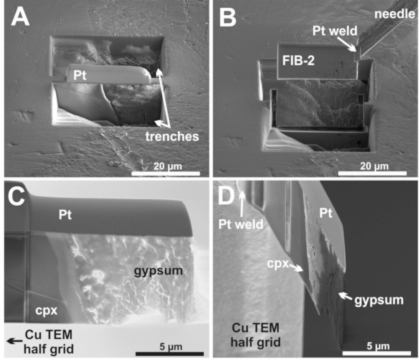
Publications
-
Hallis, L. J. (2013). Alteration assemblages in the Miller Range and Elephant Moraine regions of Antarctica: Comparisons between terrestrial igneous rocks and Martian meteorites. Meteoritics & Planetary Science, 48(2), 165–179. doi:10.1111/maps.12049
-
Hallis, L. J., Ishii, H. A., Bradley, J. P., & Taylor, G. J. (2014). Transmission electron microscope analyses of alteration phases in martian meteorite MIL 090032. Geochimica et Cosmochimica Acta, 134, 275–288. doi:10.1016/j.gca.2014.02.007
-
Hallis, L. J., Taylor, G. J., Nagashima, K., & Huss, G. R. (2012). Magmatic water in the martian meteorite Nakhla. Earth and Planetary Science Letters, 359-360, 84–92. doi:10.1016/j.epsl.2012.09.049
-
Hallis, L. J., Taylor, G. J., Nagashima, K., Huss, G. R., Needham, A. W., Grady, M. M., & Franchi, I. A. (2012). Hydrogen isotope analyses of alteration phases in the nakhlite martian meteorites. Geochimica et Cosmochimica Acta, 97, 105–119. doi:10.1016/j.gca.2012.08.017
-
PROJECT INVESTIGATORS:
-
PROJECT MEMBERS:
Lydia Hallis
Project Investigator
Karen Meech
Co-Investigator
Jeff Taylor
Co-Investigator
John Bradley
Collaborator
Jeffrey Gillis-Davis
Collaborator
Hope Ishii
Collaborator
Heather Kaluna
Collaborator
-
RELATED OBJECTIVES:
Objective 1.1
Formation and evolution of habitable planets.
Objective 2.1
Mars exploration.
Objective 3.1
Sources of prebiotic materials and catalysts
